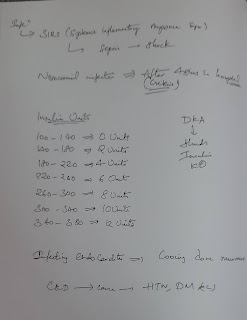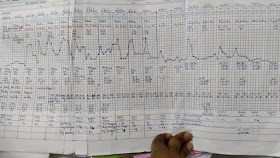paraperesis 1
General medicine
Paraparesis case
Roll no 43
Cheif complaints
Bilateral lower limb weakness since 20 days
Started proximal later progressed to bilateral distal region
Bilateral edema which is non pitting
Difficulty in squatting and getting up
Difficulty in wearing chepals
NO H/O DIFFICULTY IN COMBING HAIR , BUTTONING AND UNBUTTONING SHIRT
NO H/O CRANIAL NERVE INVOLVEMENT
Neurological weakness
1. Upper motor neuron
2. Basal ganglia and cerebellum
3. Lower motor neurons
Other causes of weakness might be
Systemic
Drug induced
Vitamin deficiency
Autoimmune diseases
Thyroid condition
On examination
Patient is coherent conscious and cooperative
general examination was normal
Higher mental status is normal
Cranial nerve functions are intact
Motor system
Tone normal
Power slightly decreased 4/5 in both lower limb
Reflexes are absent in both lower limbs
Sensory system was intact
No specific signs of meninges or cerebellar
Lab investigation
Blood
Urine
Ecg
Serology
All were normal with minor variabilities
Muscle biopsy done Not suggestive of polymylities or muscular dystrophy
Probable localisation and ruling out
Upper motor neuron lesion
From cerebral cortex to spinal cord
Symptoms of UMN lesion
Distal muscle involvement mostly
Hypertonia
Flexor weakness
Deep tendon reflexes are exaggerated
But our case show none so can rule out UMN lesion
Cerebellum
Dysdiadokinesis
Gait abnormality
Hyponia
Dysarthria
Nystagmus
Intesion tremors
Pendular knee jerk
This were not related soo cerebral lesions wer highly imposible
Lower motor neuron lesion
mostly proximal muscle are involved
atrophy of mucles
flaccidity
hypotonia
deep tendon reflexes are reduced or absent
babinski is negative
fasiculations and fibrillations are present
Lesion of LMN can be at four places on its pathway
Anterior horn cell
Peripheral nerve
NMJ
Muscle (myopathy)
To rule out Anterior horn cell disease and peripheral neuropathy , evaluation of conduction velocity (NCV), histological findings , biochemical studies are necessary.
NCV testing has to be done in the patient , which helps us to know whether it is neurogenic.
ELECTROMYOGRAPHY is done and showing normal results , from which we can rule out NMJ disorders.
It might not be drug induced no suggestive history of medication
Hypothyroidism can be ruled out by thyroid harmone status
No relapsing events so chronic demyelination polyneuropathy can be ruled out
Muscular dystrophy was ruled out by histopathology report
Case might most probably be BECKER’s Muscular dystrophy which is a X linked recessive trait
Becker Muscular Dystrophy (BMD) is an inherited disorder of muscle structure that results in progressive weakness of limb and breathing muscles. The involuntary muscles are not affected. BMD is similar to Duchenne Muscular Dystrophy (DMD), but is less severe. BMD usually begins in the teens or early adulthood, and the course is slower and far less predictable than that of DMD. Early symptoms are cramps after exercising, and later in life the person begins to experience problems while walking quickly or running. Other noticeable symptoms besides weakness are falling, feeling "worn out," and changes in the skeletal system. Few affected have learning problems, but these cases are typically minor.
causes of Becker Muscular Dystrophy
The cause of BMD is related to a deformity of a gene on the X chromosome (therefore, females are the carriers of this defect). This fault produces a protein called dystrophia that does not work the way it should within muscle fibers. This causes the fibers to gradually weaken and wear away.
Becker Muscular Dystrophy is diagnosed by
BMD can often be misdiagnosed as limb-girdle muscular dystrophy or as spinal muscular dystrophy. Blood tests can be performed if it is known that BMD runs in the family. Needle EMGs and nerve conduction studies (NCSs) can also be performed. The needle EMG will show that the muscle weakness is due to a problem with the muscles versus problems with nerves.
Rx of Becker Muscular Dystrophy
The treatment of BMD focuses on lessening the symptoms associated with it. There is no cure, but treatments are available to help with symptoms and maximize muscle function. It is vital that a person with BMD stay in shape and continue to use their muscles. This can include physical therapy. Treatment can also include genetic counseling, using splints, massages, and catabolic steroids. It is probable that the person will eventually require a wheelchair.



Comments
Post a Comment